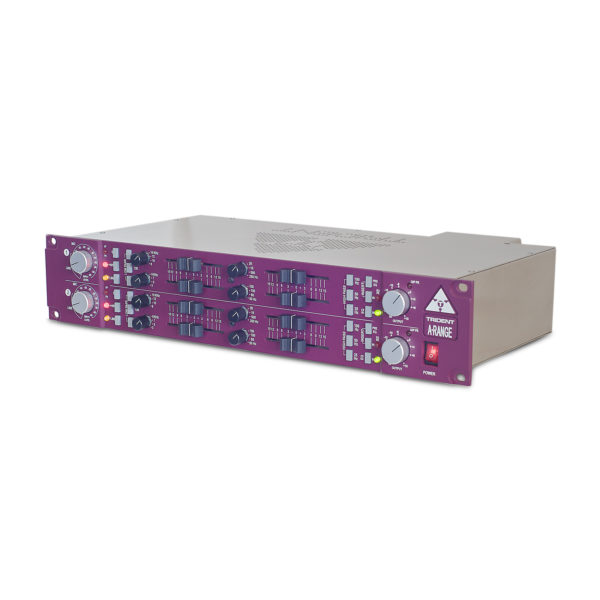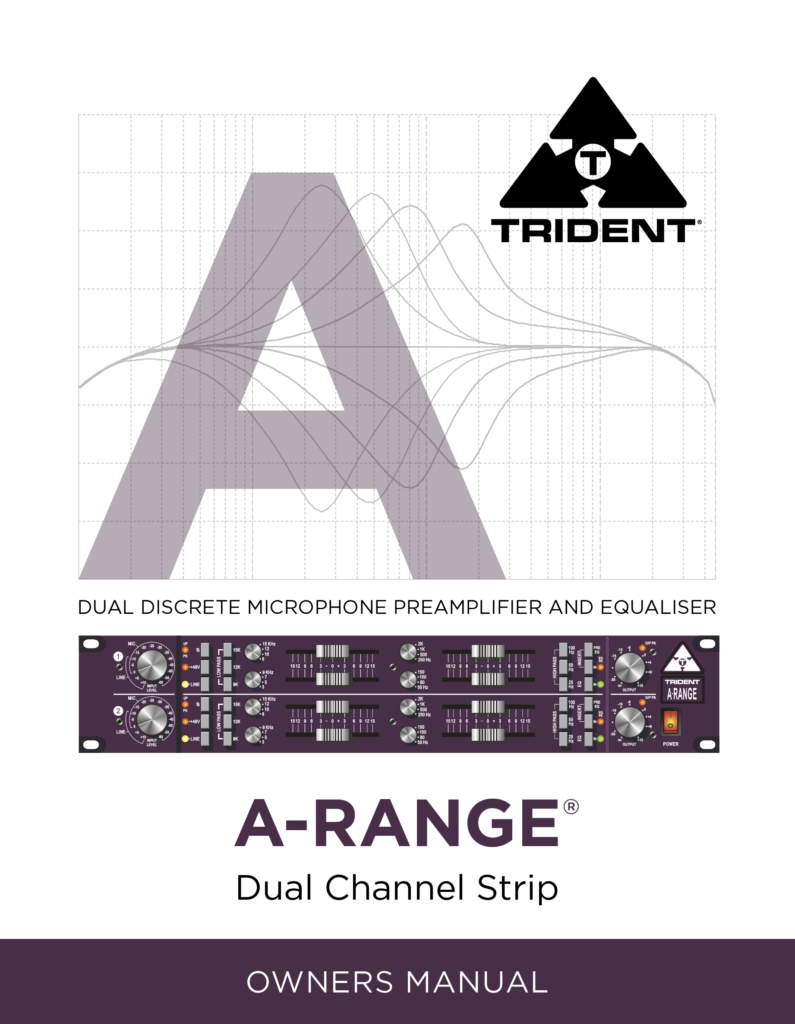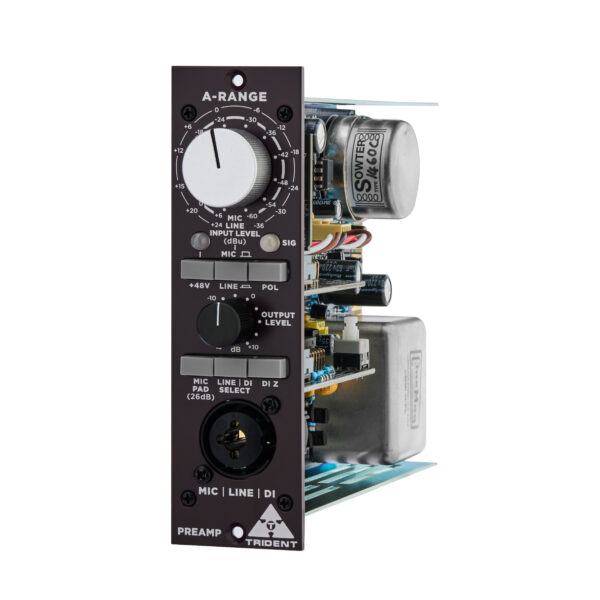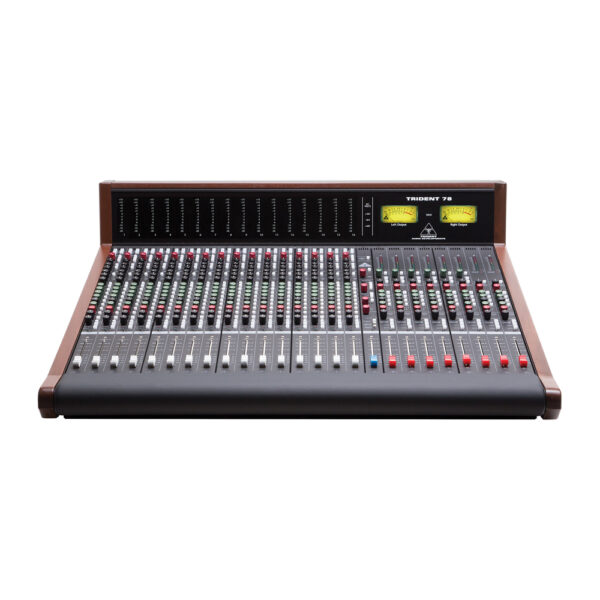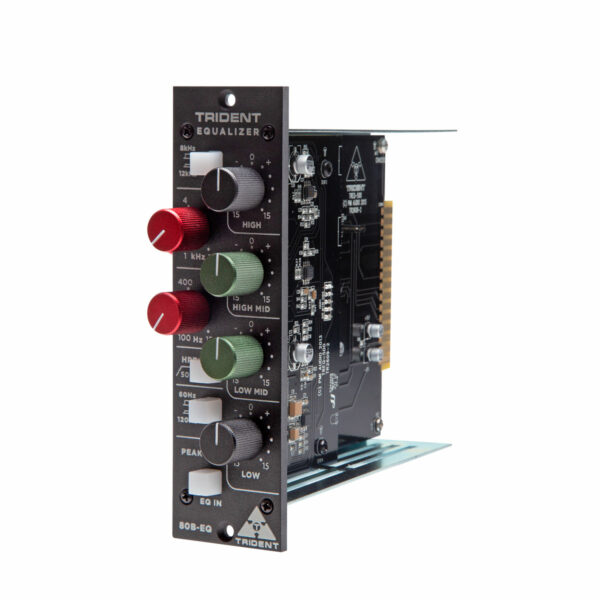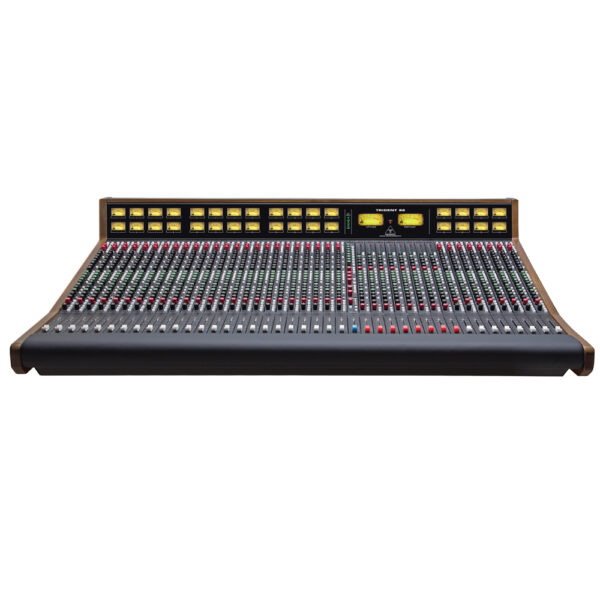- Overview
- Specifications
- Literature
- Warranty

Overview
The A-Range is a 2-channel rack-mountable version of the legendary Trident ‘A’ Range console. Comprising two independent channels, each with a microphone/line amplifier and four band equaliser, it is designed to process level instrument and incoming signals from a microphone or line level instrument and output to a recording device, such as a digital audio workstation or analog multi-track tape recorder.
Download the A-Range 19″ Dual Channel Strip manual here.
In 1972 Trident Studios decided to buy a new recording console and decided to build one themselves. The first console was designed purely for Trident Studios and was designated the A-Range. It was hand-built to the standards Trident set. In those days, the integrated circuit (or ‘chip’) had not been invented, so all of the circuits used individual transistors (known nowadays as ‘discrete’ design). This and the use of inductors in the lower and upper mid equaliser sections are said to account for much of the unique sound of the A-Range. From this first successful design was born Trident Audio Developments Ltd, which went on to become a leading manufacturer of music recording consoles. One of the company’s earliest advertising slogans was ‘designed by recording engineers for recording engineers’. This became a key component of what made the ‘Trident Sound’ unique.
The 2-channel A-Range rack unit is an exact replica of the original all-discrete transistor circuitry and faithfully follows the original console’s design. So much so that it has taken three years of circuit analysis and testing by PMI Audio Group who undertook the mammoth task of recreating the circuitry. Trident Audio Developments and PMI Audio are extremely pleased and proud to offer this unique piece of recording history. Only thirteen A-Range consoles were ever built and a number are still in use today despite being nearly forty years old. This says a lot about the heritage of these iconic items of recording equipment and the artists that have used them, which include Elton John, Dire Straits, David Bowie, Rod Stewart and Stevie Wonder to name but a few.
The Original Trident A-Range Console
Trident was undoubtedly positioned at the pinnacle of UK recording desks during the golden years of rock. Trident’s designs have certainly made an indelible impact on the sound of record making that is nearly impossible to gauge. The desks made for Trident Studios, and other studios fortunate enough to acquire them, were legendary in breakthrough flexibility and huge sound. During this time period, every record made on a Trident desk was uniquely and quite positively altered by the sonic imprint of their distinctive designs.
With only 13 consoles ever built of this model, the Trident A-Range has attained near-mythic status in the professional recording industry—particularly noted for its fantastic preamps and unusual and colorful EQ. It is interesting to note that the original desks all came in the beautiful aubergine (“eggplant”) color, which was ultimately selected by legendary producer Roy Thomas Baker.
A-Range History
The first Trident A-Range console was originally built by and for Trident Studios in 1971. When word spread about this revolutionary new multitrack recording console design, other studios became interested. In 1972, Trident Audio Developments was formed, and consoles were soon delivered. Later orders also started pouring in from America. Cherokee Studios in Los Angeles was an early recipient of one of the first production models, and ultimately purchased four new desks from Trident. David Bowie, Rod Stewart, and Frank Sinatra are among the first artists to record hits on Cherokee’s first A-Range console.
East West Studios, formerly Cello, still operates their original A-Range in Studio 3.
The smallest but arguably the most famous of their studios, the design of Studio 3 has been copied over and over by recording studios across the globe. Some of the most iconic hits of the 60s were born there. The Mamas and the Papas recorded “California Dreaming” and “Monday, Monday” in this studio, along with Scott McKenzie’s classic “San Francisco”. But one album recorded here stands above all the rest – The Beach Boy’s 1966 masterpiece Pet Sounds.
About Studio Three. @ East West Studios
http://www.eastweststudios.com/studio3/
Some of the hits just from Studio Three Include;
- 1963 The Beach Boys “Surfin USA”
- 1964 Jan and Dean “Everybody Loves Somebody”
- 1964 Barry McGuire “Eve of Destruction”
- 1965 The Beach Boys “California Girls”
- 1965 The Beach Boys “Sloop John B”
- 1965 The Mamas & the Papas “California Dreamin’”
- 1965 The Turtles “It Ain’t Me Babe”
- 1966 Scott Mackenzie “San Francisco”
- 1966The Mamas & the Papas If You Can Believe Your Eyes and Ears
- 1966 The Mamas & the Papas “Monday, Monday”
- 1966 The Mamas & the Papas “I Call Your Name”
- 1966 The Beach Boys “Good Vibrations”
- 1966 The Beach Boys “God Only Knows”
- 1966 The Beach Boys Pet Sounds
- 1966 The Beach Boys Smile Sessions
- 1966 Johnny Rivers Poor Side of Town
- 1966 The Mamas & the Papas “Dancing in the Street”
- 1966 The Turtles You Baby
- 1966 The Sunrays Andrea
- 1966 The Association Renaissance
- 1967 The Association Windy
- 1967 Johnny Rivers “Baby I Need Your Lovin’“
- 1967 The Grassroots Feelings
- 1967 The Mamas & the Papas Deliver
- 1967 The Mamas & the Papas “Creeque Alley”
- 1968 The Association Time for Living
- 1968 5th Dimension “Stone Soul Picnic”
- 1968 The Cowsills “Hair”
- 1969 The Grassroots Leaving It All Behind
- 1971 Hamilton Joe Frank & Reynolds Ain’t No Woman
- 1973 America “Goodbye, Goodbye”
- 1974 The DeFranco Family Save The Last Dance For Me
- 1976 Herb Pedersen Southwest
- 1979 Herbie Hancock Monster
- 1980 Blondie “The Tide is High”
- 1980 Blondie “Rapture”
- 1980 Dolly Parton “9 to 5”
- 1983 Bow Wow Wow When the Going Gets Tough, The Tough Get Going
- 1984 Donna Summers Cats Without Claws
- 1985 Stevie Knicks “Rock A Little”
- 1997 The Rolling Stones Bridges to Babylon
- 2001 Blink-182 Take Off Your Pants and Jacket
- 2001 Natalie Merchant Motherland
- 2001 System of a Down Toxicity
- 2002 Muse Absolution
- 2002 AFI Sing the Sorrow
- 2003 The Mars Volta De-Loused in the Comatorium
- 2003 Jimmy Eat World Futures
- 2004 Ryan Adams Love Is Hell
- 2009 Rihanna Rated R
- 2009 Band of Horses Infinite Arms
- 2010 Rihanna Loud
- 2011 Frank Ocean Channel Orange
- 2011 Nas Life is Good
- 2011 Jimmy Cliff Rebirth
- 2012 Richie Sambora Aftermath of a Lowdown
- 2012 Kelly Rowland Talk A Good Game
- 2012 Kate Nash Girl Talk
- 2012 Music for the film Behind the Candelabra
- 2012 Music for the TV Show American Horror Story
- 2012 Demi Lovato Demi
- 2012 Music for the TV Show The New Normal
- 2012 Ariana Grande Yours Truly
- 2013 Janelle Monáe The Electric Lady
- 2013 Music from the film Oblivion
- 2014 Lea Michele Louder
Another of the legendary studios to use the A-Range consoles was Chreeokee Recoding Studios in Hollywood. Cherokee studios owned at one time 4 A-Range consoles. Many bands and artisits have recorded on A-Range consoles at Chreeokee over the years including the following;
David Bowie
With Cameron Crowe documenting the recording sessions for Rolling Stone, David Bowie came to Cherokee Studios in 1975 to record his platinum album Station to Station.
Motley Crue
Mötley Crüe recorded the platinum selling albums Theatre of Pain and Shout at the Devil at Cherokee Studios.
Harry Nilsson
Harry Nilsson recorded his final album Flash Harry at Cherokee Studios between 1978 and 1980. Produced by Steve Cropper and engineered by Bruce Robb, the album has a very clean, soulful sound and features a who’s-who of collaborators including Ringo Starr, Paul Stallworth, Eric Idle and Mac Rebennack.
Bonnie Raitt
While living in one of the West Hollywood apartment complexes directly behind Cherokee Studios, Bonnie Raitt would pick up backup singing recording gigs with music producers Bruce Robb and Steve Cropper.
Frank Sinatra
Frank Sinatra recorded the Sinatra Christmas Album at Cherokee in 1975.
Ringo Starr
While he was recording Stop and Smell the Roses at Cherokee Studios in 1980, Ringo Starr invited George Harrison, Paul McCartney and Linda McCartney to guest on the album; Paul McCartney and Harrison also produced some of the tracks. Starr had approached John Lennon to help out as well, had received two demos of songs which eventually wound up on the posthumous Lennon album Milk and Honey, and reportedly, Lennon had agreed to come to Los Angeles in January 1981 and take part in the recording; the album then would have been a modest Beatles reunion. The assassination of Lennon prevented those plans from coming to fruition. Ronnie Wood of the Rolling Stones also collaborated with Starr on the album at Cherokee, adding guitar, bass, saxophone, keyboards, and back-up vocals.
Weird Al Yankovic
Weird Al Yankovic recorded his first album at Cherokee in 1982. The album sold over 500,000 copies.
Warren Zevon
In 2002, a terminally ill Warren Zevon came to Cherokee Studios to record what would be his final album, The Wind. Nick Read filmed Zevon’s final recordings at Cherokee for the documentary,Warren Zevon: Keep Me In Your Heart. Bruce Springsteen joined Zevon at Cherokee for the single “Disorder in the House,” Cherokee owner Bruce Robb provided lead guitar on the first track of The Wind and support vocals on two other tracks.
Michael Jackson
Michael Jackson‘s 1979 album Off the Wall was recorded at Cherokee Studios. The album is among the best-selling albums of all time.
Acts that have recorded at Cherokee Studios also include:
- Aerosmith
- Alice Cooper
- Automatic 7
- Barbra Streisand
- Bliss 66
- The Cars
- Concrete Blonde
- Dave Matthews Band
- David Bowie
- Device
- Devo
- Diana Ross
- Dokken
- Donovan (Lady of the Stars)
- Elis Regina
- Fear
- The Go-Go’s
- Toto
- Guns N’ Roses
- Sammy Hagar
- JetSet
- Journey
- Lillian Axe
- Korn
- Lenny Kravitz
- Lita Ford
- Rollins Band
- Steely Dan
- Stryper
- Stylus Automatic
- Suicidal Tendencies
- The Choirboys
- Thirty Seconds to Mars
- Van Halen
- X
- The Broken Homes
- Radio Active Cats
- Bihlman Bros
Specifications
| Input Impedance: | |
| Microphone: | 600 ohm transformer balanced |
| Line: | 10k ohm transformer balanced |
| Output Impedance: | |
| Less than 100 ohm electronically balanced | |
| Gain: | |
| Microphone: | 0dB to +60dB |
| Line: | -10dB to +10dB |
| Noise: | |
| Microphone: | Less than -126dBu ref 150 ohm (20Hz-20kHz) |
| Line: | Less than -85dBu (EQ In 20Hz-20kHz) |
| Maximum Levels: | |
| Mic Input: | +24dBu at all frequencies |
| Line Input: | +24dBu at all frequencies |
| Distortion: | |
| Mic Input: | Less than 0.05% T.H.D. (-50dBu input +4dBu output) |
| Line Input: | Less than 0.05% T.H.D. (+4dBu input +4dBu output) |
| Frequency Response: | |
| Mic Input: | ±1dB 20Hz to 20kHz |
| Line Input: | ±1dB 20Hz to 20kHz |
| Nominal Operating Level: | |
| +4dBu | |
| Peak LED Threshold: | |
| +10dBu |
Download Trident A-RANGE Literature
Trident Electronics Warranty
Trident Audio Developments Limited Warranty Statement
The following outlines the warranty periods for all Trident Analogue electronics. All warranty service requires Proof of Purchase. Proof of purchase is the original Bill of Sale or Sales Invoice from an authorized dealer.
Trident Audio Developments electronics are covered by a limited warranty against defects in materials and workmanship (parts and labor) for a period of One (1) Year from the date the unit is sold to the Dealer or original purchaser only.
Acceptable registration is met by registering online – click here
The terms and conditions of this limited warranty are:
- The warranty applies to Trident Audio Developments Electronics purchased from Trident Audio or authorized Trident Audio dealers.
- The warranty covers any defects in materials and workmanship and is limited to the repair or replacement of the original registered product. In its sole discretion, Trident may either repair or replace the product with a product of the same model or replace the product with a new model of a similar specification when the same model is no longer available.
- The warranty does not cover any of the following: damage caused by the user: spillages or moisture damage; neglect, abuse, or misuse, including but not limited to the failure to use the product(s) for its normal purpose in accordance with the manufacturer’s instructions for use. Failure to properly maintain the product in accordance with the manufacturer’s instructions, and/or the failure to use the products in accordance with the manufacturer’s specifications; normal wear and tear; use of products with incompatible or faulty equipment; unauthorized modifications; repairs conducted by unauthorized persons or service center’s; the model and/or serial number is altered, removed or made illegible; accidents; acts of God or any cause beyond the control of Trident Audio Developments. It does not cover damage caused by connecting to an improper power voltage supply, cosmetic defects, such as paint finish, and general wear and tear, as well as certain consumables not covered under warranty such as fuses, faders, pots, switches, and meter bulbs. Mechanical components including but are not limited to a consumable item; potentiometers, faders, and switches are covered by a 90-day warranty. Failure to maintain, damage; neglect, abuse, or misuse of any mechanical components in this time will result in a void warranty. Trident recommends regular service of the product and in particular; regular service of the mechanical components such as potentiometers and faders.
- The warranty is applicable to the original purchaser throughout the warranty period as stated above or until the original owner resells the product. If a unit is received for warranty repair, and after complete examination and testing, no problem is found with the unit, the customer will be charged for time labor plus return shipping costs, presuming initial user error falsely caused the unit to be determined faulty.
- The warranty does not affect any statutory rights the original purchaser may have in accordance with the law applicable in the jurisdiction where the product was purchased, or any rights the original purchaser may have against the authorized dealer pursuant to their original purchase agreement. This warranty gives you specific legal rights and you may also have other rights, which vary from state to state, and or country to country.Any claim pursuant to this warranty from the date of purchase of any Trident Audio Developments product must be returned, together with the original proof of purchase, to the authorized Trident Audio dealer that sold the product, or to the Trident Audio service center in the USA or our UK service center. All returns to Trident Audio, or any Trident Audio Service Center must be in the original packing, accompanied by the issued Repair Authorization, and must be shipped to the address specified on the Return Authorization via insured freight at the customer’s own expense. Factory original packaging can be ordered from Trident Audio, Inc. Customer will be charged for new factory original packaging if the customer fails to ship product to Trident Audio in the original factory packaging. Trident Audio will not pay for express or overnight delivery.
- Once the product has been received, the authorized Trident Audio service center will assess the warranty claim and arrange to either repair or replace it in accordance with the warranty procedure prescribed by Trident Audio for their authorized service center network. The warranty replacement will be conducted by the authorized Trident Audio service center as promptly as possible and within a reasonable time from the date of submission of the warranty claim. In all circumstances, a claimant under this warranty will be liable for all costs in delivering their Trident Audio brand product to the authorized service center for warranty replacement and for all costs in collecting the repaired/replacement Trident Audio product from that authorized Trident Audio service center. Trident Audio service center may waive the cost of return shipping after full inspection to determine the cause of the warranty.
- Trident Audio will not accept any warranty replacement without the original proof of purchase of the Trident Audio product, and without the registration of the Trident Audio product within 30 days of purchase by mail, or online. It is the original purchaser’s responsibility to keep the original proof of purchase or copy safe at all times, as Trident Audio is not obliged to provide a replacement of the original proof of purchase.
- The warrantor assumes no liability for property damage or any other incidental or consequential damage whatsoever which may result from the failure of this product.
- A Trident Audio product that was not purchased through an authorized and legitimate sales channel is considered “Grey Market”. Warranties for Trident Audio Products purchased outside the USA will be covered by its Trident Audio UK Service Center. Trident Audio product originally sold to the USA market and consequently resold overseas forfeits its warranty. “Grey Market” purchases are not covered by any warranty. In the case that a Trident Audio Product must be returned, it should be returned to the original place of purchase, or the Trident Audio factory, with a proper return authorization. Returns from outside the USA, the customer shall adhere to specific shipping, customs, and commercial invoicing instructions given with the Return Authorization. Trident Audio will not be responsible for transportation costs or customs fees related to any importation or reexportation charges whatsoever.
- Trident Audio shall not be liable for damages in excess of the purchase price of the Trident Audio product arising out of the use or inability to use the Trident Audio product.
Governing Laws
Any dispute, controversy or claim arising out of or relating to this Agreement shall be decided by arbitration in Los Angeles, California, in accordance with the rules of the American Arbitration Association (the “Association) then in effect. Any award rendered by the Association shall be final, binding and not subject to appeal, and may be enforced by any court of competent jurisdiction.
For Tech Support and Repair Authorization, please contact: US Service & Sales 1845 W. 169th Street Gardena, CA 90247 at +1 (310) 323-9050 or sales@tridentaudiodevelopments.com
Trident Audio Developments is a registered trademark of PMI Audio Group
©2010 PMI Audio GroupFeatures and specifications are subject to change without notice.

Plug-in Features and Controls
1. LOUD
A color-coded (red) knob provides controls for loudness compensation within the range of -6 to +6 (cut/boost intensity level). Click the knob and drag up to increase the value and drag down to decrease. Alternatively, double-click on the rotary knob to manually enter a value.
2. LOUD BYPASS
Press the IN button above the LOUD control to enable (backlight on) or disable (backlight off) the loudness compensation function.
3. TILT
A color-coded (black) knob provides controls for tilt equalization within the range of -6 to +6 (cut/boost intensity level). Click the knob and drag up to increase the value (favoring high frequencies) and drag down to decrease (favoring low frequencies). Alternatively, double-click on the rotary knob to manually enter a value.
4. TILT BYPASS
Press the IN button above the TILT control to enable (backlight on) or disable (backlight off) the Tilt equalization function.
5. HIGH PASS FILTER – Slope (dB)
A color-coded (green) rotary knob sets the high pass filter slope in dB per octave, within the range of 0 dB/Off (Off=default) to 18 dB. Click the knob and drag up to increase the value and drag down to decrease. Alternatively, double-click on the rotary knob to manually enter a value.
6. HIGH PASS FILTER – Frequency (Hz)
A color-coded (green) rotary knob sets the high pass corner frequency within the range of 100 Hz to 400 Hz. Click the knob and drag up to increase the frequency and drag down to decrease. Alternatively, double-click on the rotary knob to manually enter a value.
7. HIGH PASS FILTER – Bypass
Press the IN button above the HPF controls to enable (backlight on) or disable (backlight off) the high pass filter function.
8. LOW PASS FILTER – Slope (dB)
A color-coded (green) rotary knob sets the low pass filter slope in dB per octave, within the range of 0 dB/Off (Off=default) to 18 dB. Click the knob and drag up to increase the value and drag down to decrease. Alternatively, double-click on the rotary knob to manually enter a value.
9. LOW PASS FILTER – Frequency (Hz)
A color-coded (green) rotary knob sets the low pass filter corner frequency within 4 kHz to 15 kHz. Click the knob and drag up to increase the frequency and drag down to decrease. Alternatively, double-click on the rotary knob to manually enter a value.
10. LOW PASS FILTER – Bypass
Press the IN button above the LPF controls to enable (backlight on) or disable (backlight off) the low pass filter function.
11. SATURATION
A color-coded (black) rotary knob sets the saturation enhancement level within the range of 0 (MIN) and 100 (MAX). Click the knob and drag up to increase the value and drag down to decrease. Alternatively, double-click on the rotary knob to manually enter a value.
12. SATURATION Bypass
Press the IN button above the SATURATION control to enable (backlight on) or disable (backlight off) the saturation enhancement function.
13. OUTPUT
A color-coded (red) rotary knob sets the output gain level within the range of -16 dB to +16 dB. Click the knob and drag up to increase the value and drag down to decrease. Alternatively, double-click on the rotary knob to manually enter a value.
14. POLARITY (Ø)
Press the Ø button above the OUTPUT control to invert the signal polarity (backlight on) or maintain the current polarity (backlight off).
15. METERING
Press the ON button above the VU meter to enable (backlight on) or disable (backlight off) the VU and PPM metering functions.
16. 0 VU CALIBRATION
Use the -8.0 or -18.0 radio buttons above the VU meter to toggle between a 0 VU calibration level of -8.0 dBFS or -18 dBFS respectively. NOTE: Calibration applies to the VU meter only; the PPM meter range is mapped directly to peak values between -20 and +3 dBFS.
iLok License Manager is used for software activation (2 activations per license). For more information about iLok License Manager, please visit ilok.com.
